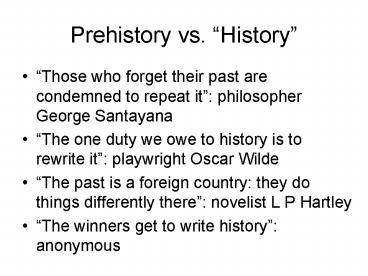Prehistory vs' History - PowerPoint PPT Presentation
1 / 19
Title:
Prehistory vs' History
Description:
Stone. Basic survival or subsistence level. Influenced by ... Neolithic Era - New Stone Age. Actually transition from nomadic society to sedentary society ... – PowerPoint PPT presentation
Number of Views:136
Avg rating:3.0/5.0
Title: Prehistory vs' History
1
Prehistory vs. History
- Those who forget their past are condemned to
repeat it philosopher George Santayana - The one duty we owe to history is to rewrite
it playwright Oscar Wilde - The past is a foreign country they do things
differently there novelist L P Hartley - The winners get to write history anonymous
2
Regionalization
3
Transition from Paleolithic Neolithic
Neolithic Civilization
- Prehistory to Postclassical World
- 8000 BCE to 600 CE
4
Paleolithic Era (3 million/250,000 ca. 10,000
bce)
- Type of tools
- Stone
- Basic survival or subsistence level
- Influenced by climate and climate changes
- Nomadic
- Hunters and gatherers
- Bands
- About 30-50
- Family and culture groups
- General social equality
- Economic roles a little different but the burden
of the tasks and the level of responsibility and
decision making was based on need not
pre-established roles - Women gathered berries, nuts etc.
- Men hunters
- Natufian society of the eastern Mediterranean
5
Pre-Historic Man in the Paleolithic Age
(Different than ancient man)
6
Population Urban areas
- Steady increase in population following Neolithic
Revolution - 4 million in 10,000 bce
- 5 million in 5000 bce
- 14 million in 3000 bce
- 100 million by 500 bce
- Change from villages to urban city-states
- First major urban areas
- Jericho
- Catal Huyuk
- Economic activity diversifies (Industries)
- Pottery (useful, technological advancements,
artistic) - Metallurgy (copper, bronze, iron)
- Textile (fabrics)
7
10,000 BCE 1000 CE
From 4 million in 10,000 BCE to 100 million at
the beginning of the classic era or 500 BCE
8
1000 CE 2000 CE
Current life expectancy 67
9
Technology links
10
Regional discoveries of cultural representations
during Paleolithic and early Neolithic Eras
11
Neolithic Era - New Stone Age
- Actually transition from nomadic society to
sedentary society - Type of living changed from caves and open areas
to actual dwellings - Migration continues but slows
- Population numbers increase causing the need for
more complex relationships and systems to support
them
12
Venus Figures
- Mother Goddess
- Fertility icons
- Prehistoric
- Earliest findings dated 35,000 years ago
- swollen belly, wide-set thighs, and large breasts
Venus Malta
Venus of Willendorf
13
Example of some early houses in Neolithic villages
14
Villages to cities (states)
- The villages become walled cities and urban areas
- Catal Huyuk and Jericho
- The new agricultural civilizations had to protect
their land and develop complex systems to support
the growing population
15
Neolithic or Agricultural Transition
- Shift from food gathering to food producing
- Result is people begin to settle in one place
- Cities develop
- Surplus begins
- Impact is complex societies or civilizations that
have trade networks and are interconnected - Neolithic Revolution is the basis for more
complex societies to be formed - Sedentary
- Surplus
- Diverse economic activity
- Division of labor
- Gender roles begin to change and become less
equal - Need for complex record keeping
- Writing systems
- Pictographic (drew pictures to represent physical
aspects) - Ideographs (drew pictures to represent abstract)
- Phonographs (drew symbols to represent sounds)
- Alphabet and writing systems
16
Development of Writing
- Out of economic need to keep records
- Impacts social hierarchy (those who can write and
those who cant) - For historians the issue is from whose
perspective do we receive the written history - Develops in similar pattern but final style is
different as are other cultural representations
17
Civilization or complex societies
- When do we know it is a civilization or matches
other complex societies and is no longer
Neolithic and able to sustain itself over
generations. - It may adapt/evolve over many generations
- Rates of adaptation are influenced by geography,
type of culture, and creation of technology - 5-6 elements of Civilization
- Division of labor
- Advanced technology
- System of Writing
- Calendar
- Cities with Government or system of control
- Usually some element within culture of philosophy
that holds them together and explains the forces
of nature
18
Urban areas
- Population (biological)
- Culture
- State
- Gender
- Work
- Leisure
- Ritual centers (temples)
19
Revolution or Transition?What does the
transition impact
- What causes the impact?
- Ability to control environment
- Slash and burn techniques
- Irrigation
- People stop roaming and build villages first then
cities as population grew and methods developed - Impact is civilization
- Subsistence to surplus
- Trade networks within area creates relationship
with the cities and culture groups creating
empires - Empires and areas connect through trade
exchanging technology and goods that assist in
overcoming environment and cause adaptation rate
to increase - Also causes more conflict
- Luxury items traded longer distances
- You can track these items to see who traded with
who

